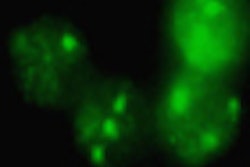
NEW YORK (Reuters Health), Apr 9 - Accelerated radiation therapy is more effective than conventional fractionation for squamous cell carcinoma of the head and neck (HNSCC), but complications of treatment are more common, investigators report.
The success of radiotherapy for these cancers depends on the extent of tumor stem cell proliferation during radiation. For this reason, shortening the treatment time without reducing the dose is an attractive option, the authors explain in their April 9 online report in The Lancet Oncology. Studies have already affirmed that this approach may be beneficial in industrial nations.
But the goal of this trial was to examine accelerated fractionation for patients with HNSCC in resource-limited settings, "where there are fewer therapeutic resources and where tumor burdens can be heavier," note lead author Dr. Jens Overgaard, from Aarhus University Hospital, Denmark, and associates. Seventy percent of these cancers occur in developing countries, they say.
The 900 patients -- from Asia, eastern Europe, the Middle East, Africa, and South America -- all had stage 1-4 invasive squamous-cell carcinoma of the larynx, pharynx, or oral cavity, with no distant spread.
Between 1999 and 2004, the researchers randomly assigned them to five (n = 448) or six (n = 452) fractions per week of 2 Gy (median treatment time, 40 and 47 days, respectively). Tumors were treated with doses of 66-70 Gy in 33-35 fractions.
The five-year actuarial rate of locoregional control was 42% in the accelerated group versus 30% in the conventional group. There was no difference in the effect on lymph nodes. In subgroup analyses, accelerated fractionation had the most benefit in laryngeal tumors and less benefit in advanced tumors at any site with a large nodal burden.
At five years, the actuarial rate of disease-free survival was 50% in the accelerated group and 40% in the conventional group (p = 0.03). Corresponding overall survival was 35% and 28% (p = 0.07).
In multivariate analysis, negative neck nodes, smaller tumor size (T1-T2), and six fractions per week were significant independent predictors of a good prognosis.
Severe skin reactions (20% vs. 11%), confluent mucositis (10% vs. 5%), and mucosal reaction requiring tube feeding (52% vs. 45%) occurred significantly more often with accelerated treatment.
Late morbidity, however -- moderate or severe fibrosis, laryngeal edema, or xerostomia -- did not differ significantly by treatment schedule.
Dr. Overgaard's group concludes that the accelerated regimen is more effective than conventional fractionation, "and since it does not require additional resources it might be a suitable new international standard of treatment."
Lancet Oncol 2010.
Last Updated: 2010-04-08 18:30:30 -0400 (Reuters Health)
Related Reading
RT plus chemo can preserve larynx in head and neck cancer, February 26, 2010
Adverse effects common with chemoradiation for head and neck cancer, December 22, 2009
Concurrent chemo + radiation increases survival in advanced head, neck cancer, October 29, 2009
Radiation therapy slows return of head/neck cancer, September 15, 2009
Protons promise lower second cancer risk, May 9, 2009
Copyright © 2010 Reuters Limited. All rights reserved. Republication or redistribution of Reuters content, including by framing or similar means, is expressly prohibited without the prior written consent of Reuters. Reuters shall not be liable for any errors or delays in the content, or for any actions taken in reliance thereon. Reuters and the Reuters sphere logo are registered trademarks and trademarks of the Reuters group of companies around the world.


















